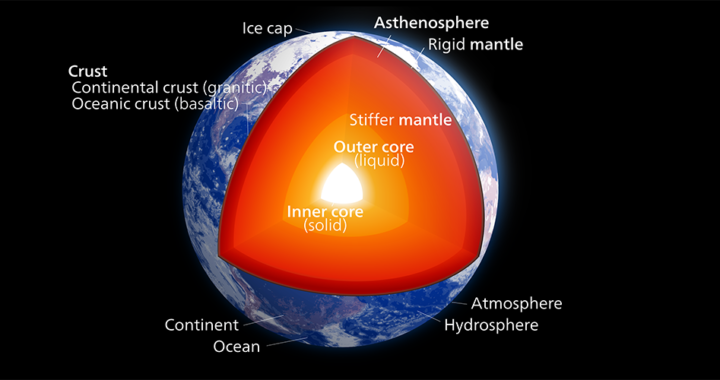The structure of the Earth consists of various spherical shells or layers that can be categorized in two manners: either by their chemical compositions or mechanical properties. Hence, based on this properties, compositional layers and mechanical layers are the two types of layers of the Earth.
Categorizing the Structure of the Earth: The Difference Between Compositional Layers and Mechanical Layers
The Compositional Layers of the Earth
Perhaps, the most discussed and cited layers are the compositional layers. Also known as the chemical layers, they include the crust, mantle, and the core. They are called the “compositional” or “chemical” layers because they correspond to their material or elemental compositions
Below are brief overviews of the compositional layers of the Earth:
• Crust: The crust is the outermost chemical layer that ranges from 5 to 70 kilometers. It is further categorized into thinner parts called the oceanic crust, and the thicker parts called the continental crust. The oceanic crust underlies the oceanic basins composed mostly of igneous rocks made from iron magnesium silicate. The continental crust is composed primarily of sodium potassium aluminum silicate rocks.
• Mantle: The mantle is the thickest layer that extends to a depth of around 2890 kilometers. It is also divided into the upper mantle and lower mantle, both composed of silicate rocks rich in iron and magnesium. Note that the mantle is solid. However, at the upper mantle, high temperatures make the silicate material considerably ductile, thus allowing it to flow. The material in the lower mantle flows less easily because of the intense and increasing pressure.
• Core: The core consists of denser materials composed primarily of iron and nickel. Note that it is divided between the outer core, which is about 2400 kilometers thick, and the inner core, which has a radius of 1220 kilometers. The outer core is liquid, while the inner core is primarily a solid ball with a temperature similar to the surface of the Sun. Of course, there is still no direct evidence about the exact composition of the core.
The Mechanical Layers of the Earth
The structure of the Earth can also be defined and divided based on how the insides of the planet behave. Thereby, the mechanical layers correspond to the physical or mechanical properties of these layers.
Below are brief overviews of the five mechanical layers of the Earth:
• Lithosphere: The lithosphere is the outermost layer of the Earth that consists of the entire crust and the top-most portion of the mantle. Furthermore, they are divided into pieces called tectonic plates. The movements of these plates are responsible for mountain-building, oceanic trench formation, earthquakes, and volcanic eruption.
• Asthenosphere: The asthenosphere includes the soft layer of the mantle on which the lithosphere moves. Remember that it is made of solid silicate materials, but the high temperature allows it to flow on very long timescales. The lithosphere-asthenosphere boundary is where geophysicists mark the difference in ductility between the two layers.
• Mesosphere: The mesosphere is the layer below the asthenosphere but above the outer core. It is essentially the lower mantle. Despite its high temperature, the intense pressure in this region restricts the movements of the molecules of the silicate material despite being under high temperature, thus making it extremely rigid.
• Outer Core: The outer core extends from the bottom of the mesosphere or the lower mantle and surrounds the inner core. Composed of iron and nickel, the extreme temperature allows these metals to remain in their liquid phases. It is the only layer of the Earth that is a true liquid. Furthermore, its movement is responsible for generating the magnetic field.
• Inner Core: The inner core is also made of iron and some nickel. However, unlike the outer core, it is a solid ball. The solidity is due to the intense pressure from the upper layers. Hence, although it is as hot as the surface of the Sun, there is speculation that the inner core is slowly growing as the liquid outer core at the boundary with the inner core cools and solidifies due to the gradual interior cooling.





